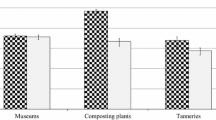Abstract
Aspergillus versicolor, which has been isolated from several mould affected houses was shown by laboratory studies under axenic conditions to produce several specific volatile compounds on water agar. These compounds were not produced by the fungus when grown on a rich malt extract medium or on several synthetic media. The volatile compounds were analysed by GC-MS. The majority of the peaks represented aromatic compounds. A non-aromatic substance which previously has been revealed by us among prominent volatile compounds sampled from building materials from so-called ‘mould houses’ was produced only on water agar. According to a comparison with the mass spectrum and retention time of pure reference compound this compound is ethylhexanol, a compound not previously reported as a mould metabolite. The presence of this compound was correlated with pungent odor in the cultures.
Similar content being viewed by others
References
Mølhave L, Bach B, Pedersen OF. Human reactions to low concentrations of volatile organic compounds. Environ International 1986; 12: 167–175.
Kaminski E, Stawicki S, Wasowicz E. Volatile flavour compounds produced by molds of Aspergillus, Penicillium and Fungi imperfecti. Appl Microbiol 1974; 27(6): 1001–1004.
Siefert RM, King DA. Identification of some volatile constituents of Aspergillus clavatus. J Agric Food Chem 1982; 30: 786–790.
Lanza E, Ko KH, Palmer JK. Aroma production by cultures of Ceratocystis moniliformis. J Agric Food Chem 1976; 24(6): 1247–1250.
Bjurman J, Kristensson J. Production of volatile metabolites by the soft rot fungus Chaetomium globosum on building materials and defined media. Microbios (in press).
Grove JF. Volatile compounds from the mycelium of the mushroom Agaricus bisporus. Phytochemistry 1981; 20:2021–2022.
Hyppel A. Fingerprint of a mould odor. Indoor Air, Stockholm, 1984.
Höll VW. Eine Dunnschichtchromatographissche Darstellung des Jahresgangs Löslicher Zuker im Stammholz von drei Angiospermen und einer Gymnosperme. Holzforschung 1981; 35: 173–175.
Tribe HT, Mabadeje SA. Growth of moulds on media prepared without organic nutrients. Trans Brit Mycol Soc 1972; 58: 127–137.
Aharonowitz Y, Demain AL. Carbon catabolite regulation of cephalosporin production in Streptomyces clavuligerus. Antimicrob Agents Chemother 1978; 14: 159–164.
Sax NI. Dangerous properties of industrial materials 6th ed. New York: Van Nostrand Reinhold Company, 1984.
Kuenzi MT. Regulation of cephalosporin synthesis in Cephalosporium acremonium by phosphate and glucose. Arch Microbiol 1980; 128: 78–82.
Ramaswami SK, Briscese P, Garguillo RJ, Geldern T. Sesquiterpene hydrocarbons from mass confusion to orderly line up. In. Flavour and Fragrances: A world perspective. Proceedings of the 10th International Congress of Essential Oils, Fragrances and Flavours, Washington DC, USA, 16–20 November 1986.
Author information
Authors and Affiliations
Rights and permissions
About this article
Cite this article
Bjurman, J., Kristensson, J. Volatile production by Aspergillus versicolor as a possible cause of odor in houses affected by fungi. Mycopathologia 118, 173–178 (1992). https://doi.org/10.1007/BF00437151
Received:
Accepted:
Issue Date:
DOI: https://doi.org/10.1007/BF00437151




